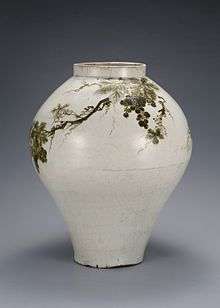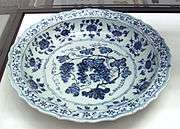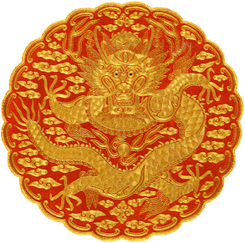Joseon white porcelain
| Joseon white porcelain | |
 Jar with green colour plant decoration, Joseon dynasty (National Treasure No. 107) | |
| Korean name | |
|---|---|
| Hangul | 조선백자 |
| Hanja | 朝鮮白磁 |
| Revised Romanization | Joseon baekja |
| McCune–Reischauer | Chosŏn paekcha |
Joseon white porcelain or Joseon baekja refers to the white porcelains produced during the Joseon dynasty (1392-1910).
History
White porcelains were preferred and praised over other porcelains during the time to represent Korean Confucian ethics such as frugality and pragmatism.[1]
In overall, Joseon ceramics underwent numerous transformations during the five hundred-year period and is generally divided into three major periods; the early, the middle, and the late period.
Although the chronology of Joseon ceramics differs between scholars, three major events affected kiln production; the outcome of the Imjin wars, the establishment of Bunwon (hangul: 분원; hanja: 分院), government-subsidized kilns at Bunwon-ri, Gwangju near Seoul in 1751, and the privatization of Bunwon in 1884.[2]
A number of Joseon porcelain has been registered by the government as National Treasures.
Characteristics
Joseon white porcelains are characterized by the beauty of unpretentious forms, understated decoration, and subtle use of color, reflecting the ideals of Korean Confucian state.
Gallery
 Jar with red bambus decoration (National Treasure No. 166)
Jar with red bambus decoration (National Treasure No. 166) Pot with blue painted pattern of plum blossom, birds and bamboo (National Treasure No. 170)
Pot with blue painted pattern of plum blossom, birds and bamboo (National Treasure No. 170) Bowl with inlaid lotus and arabesque design (National Treasure No. 175)
Bowl with inlaid lotus and arabesque design (National Treasure No. 175).jpg) Moon jar (National Treasure No. 310)
Moon jar (National Treasure No. 310)
See also
References
- ↑ James Hoare; Susan Pares (1988). Korean, An Introduction. Routledge. p. 143 p. ISBN 0-7103-0299-1. Retrieved 2008-03-29.
- ↑ John Onians (2004). Atlas of World Art. Laurence King Publishing. p. 205p. ISBN 1-85669-377-5.
Government-sponsored kilns at punwon-ri, near Seoul, produced an exquisite and distinctive Joseon white porcelain for use at court and for export to China. Its undecorated cream-colored surfaces, and austere elegant shapes were thought to reflect a purity of mind and moral character appropriate for Neo-Confucian patrons.
Further reading
- Jae-yeol Kim (2003). Handbook of Korean Art (White Porcelain and Punch'ong Ware). Laurence King Publishing. ISBN 1-85669-359-7.
- Yun, Yong-i; Regina Krahl (2005). Korean Art from the Gompertz and Other Collections in the Fitzwilliam Museum. Translated by Youngsook Pak; Roderick Whitfield. Cambridge University Press. ISBN 0-521-83592-5.
- Keith Pratt; Richard Rutt; James Hoare (1999). Korea: A Historical and Cultural Dictionary. Routledge. ISBN 0-7007-0464-7.
- Goro Akaboshi; Heiichiro Nakamaru (1975). Five Centuries of Korean Ceramics (Pottery and Porcelain of the Yi Dynasty). Weatherhill. ISBN 0-8348-1514-1.
- Claire Roberts; Michael Brand; Powerhouse Museum; Queensland Art Gallery (2000). Earth, Spirit, Fire: Korean Masterpieces of the Choson Dynasty. Queensland Art Gallery. ISBN 1-86317-080-4.
- Lee, Soyoung (October 2004). ""In Pursuit of White: Porcelain in the Chosôn Dynasty, 1392–1910 "". In Timeline of Art History. The Metropolitan Museum of Art, New York City. Retrieved 2008-03-27.
- "White porcelain (백자 白磁)" (in Korean). Empas/EncyKorea. Retrieved 2008-03-27.
- "White porcelain (백자 白磁)" (in Korean). Empas/Encyclopædia Britannica. Retrieved 2008-03-27.
External links
![]()
- Gallery of Korean Pottery and Porcelain at Korean Overseas Culture and Information Service (KOIS)



.jpg)
